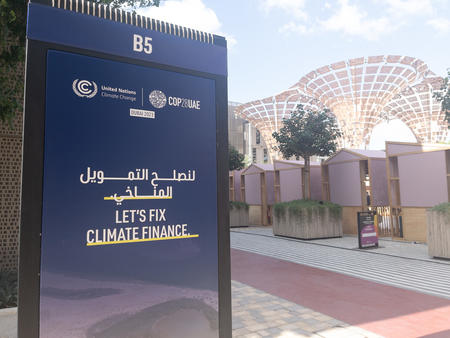A tale of two halves – some progress but is it enough?
Mike Peirce, Executive Director, Systems Change
Two powerful stories of the energy transition seized our attention this year.
A first narrative emphasised the positive potential of a rapid growth in renewables capacity, with a landmark reached in September as the G20 agreed to “pursue and encourage efforts to triple renewable energy capacity globally”. Supplementing this opportunity-focused message was the essential point that the cheapest form of energy is the energy that you don’t use – with a call from the International Energy Agency amongst others to double efficiency progress from 2% to 4% each year until 2030.
The second narrative homed in on fossil fuels – addressing the negotiating sticking points that came to the fore at the close of COP26 in Glasgow around phase down and phase out, abated and unabated. The We Mean Business coalition’s Fossil to Clean campaign exemplified this message, with over 200 companies representing over $1.5 trillion in revenue urging governments ahead of COP to ramp up clean energy and, notably, also to phase out fossil fuels.
So it’s broadly positive that these two themes have landed in the COP28 agreement signed this morning and some relief that transitioning away from fossil fuels was included in the deal at all – a first time ever in a COP text.
There’s relief in the text’s recognition that the climate crisis is a fossil fuel crisis, with a clear call on nations to transition away from coal, oil and gas. Relief, in particular, that the text highlights the importance of emissions reduction in the decade ahead and not just through a net zero position by mid-century. There’s also a silver lining that the role of carbon capture has been highlighted for hard to abate sectors and low carbon hydrogen production. And, in an improvement on the draft text, the final agreement summarises the key components, that taken as a whole, are essential for the transition (including the tripling of renewables and doubling of efficiency) rather than seeing these as part of a pick-and-mix of options.
But there’s also disappointment that, alongside these hard-won elements, we see a whole section on ‘transition’ fuels such as natural gas, when the science makes clear that this represents a methane-heavy fossil fuel. There’s frustration that ‘phase out’ has morphed into ‘phase down unabated coal’, when a 1.5 degree path must clarify we can have no new coal mining or investment. And - perhaps setting the tone for the next years of debate - we can see the emergence of new challenges to define and measure our progress: a yes to phasing out fossil fuel subsidies, but how will ‘inefficient’ subsidies be defined?

Missed opportunities on climate finance – no clear roadmap to fund a just and equitable transition
Champa Patel, Executive Director Governments and Policy
It started off so well. First, the unexpected announcement on the opening day on the setting up of the Loss and Damages fund with an initial $700 million pledge. Then multiple financial pledges across the week on food, nature, methane and disaster relief. Development banks, businesses and philanthropists seemed to fall over each other to make one eye watering announcement after another, including an additional $3.5 billion to the Green Climate Fund, with total pledges now at $12.8 billion.
But scratch a little under the surface and all is not as it seems. First of all the funds do not come remotely close to what is needed to meet mitigation and adaptation goals as well as cover loss and damages. Losses and damages alone, in developing countries, amount to at least $400 billion a year. The scale of the challenge dwarfs the amounts pledged.
More problematically, in some respects, are the paragraphs we lost along the way. It is clear that developed economies have a historical and moral responsibility to support developing economies to fund the transition. Yet the wording in the Global Goal on Adaptation is vague on this aspect and reference to developed countries has been removed to be replaced with a broad call to ensure ‘continuous and enhanced international support.’ Not naming a problem does not make it disappear. Developed economies will need to bring much greater finance and investment to the table if there is to be any chance of keeping global temperature rise to 1.5 degrees.
This lack of precision is also evident in the Global Stocktake. Where are the actionable commitments on new sources of financing or ways of scaling up existing financing? There is also nothing new on means of implementation. For developing countries and small island states, at the frontlines of extreme weather events, the package goes nowhere near close to identifying how the challenges of transition will be met.
The task now falls to Baku – next year’s COP host - to deal with the climate finance challenge. But we cannot wait for that. We need bottom-up financing as well as effective international climate finance flows, and there is so much more that can be done in bringing governments and business together to creatively identify new sources of revenue.

A great success for multilevel action as finally subnational actors are recognised
Nehmat Kaur, Head of Subnational Governments and Under2, and Urszula Kasparek, Senior Manager, International Advocacy
Finally! COP has opened the door in realising the important role of subnational governments as critical partners in achieving the goals of the Paris Agreement at the scale and urgency we need. State and regional governments often have the devolved power to drive net zero transition, including raising their own revenue, but are not formally recognised in international climate processes. This is despite the fact that subnational governments, in many instances, are more progressive and ambitious than their national counterparts - where we have seen recent trends of some governments adopting lower ambition.
At COP, we saw a greater focus on the role of cities, states and regions than has previously been the case. The first ever Local Climate Action Summit (LCAS) for governors and mayors saw subnational leaders from across the world participate in the formal COP agenda for the first time. These leaders took to the same stage as world leaders to discuss their leading role in driving transformational change and to call for greater collaboration. During the Summit, more than 70 national governments endorsed support for the role of subnational governments to contribute to NDCs and progress reviews through the newly established Coalition for High Ambition Multilevel Partnership (CHAMP).
Subnational governments also engaged hard with the negotiations themselves, through the Local Government and Municipal Authority (LGMA). This resulted in seven relevant paragraphs mentioning states and regional governments being included in the Global Stocktake. In particular, a big win for subnational governments is the explicit inclusion for national governments “to join efforts to accelerate delivery through inclusive, multilevel, gender-responsive and cooperative action;” And in the Global Goal on Adaptation, subnational advocacy resulted in five relevant paragraphs referencing non-Party stakeholders. There is now an opportunity to localise and regionalise adaptation action on the ground, which is appropriate given the fact that subnational governments are often the first responders in climate emergencies.
Finally, subnational governments spoke up in the sidelines everywhere – and seemingly all at once. Whether in the Multilevel Action and Urbanization pavilion or the Under2 Coalition General Assembly, these governments asked the tough questions and they gave their views clearly on issues where they collectively have vast experience. On fossil fuels, loss and damage, reducing methane emissions and increasing efforts on adaptation and resilience, subnational governments took charge and showcased their leadership.
On an individual level, Scotland committed new funding for clean and reliable energy in three African countries, California formally launched a Subnational Methane Action Partnership with 15 governments and Catalonia and California announced a Mediterranean Climate Action Partnership for 14 states and regions with similar weather patterns.
But commitments – and recognition – alone do not equal impact. More effort will be needed to ensure that there is subnational inclusion in the next NDC process, as well as a consistent flow of climate investment to all levels of government. States and regions have a powerful role to play in meeting net zero goals. The UAE Consensus has opened the door to them continuing to do so. But it is just a start and we will continue to push for more.


